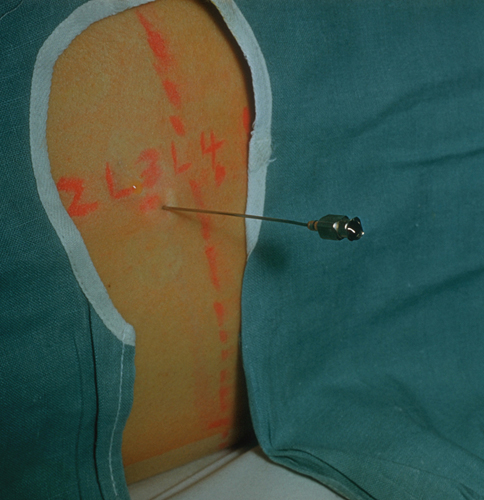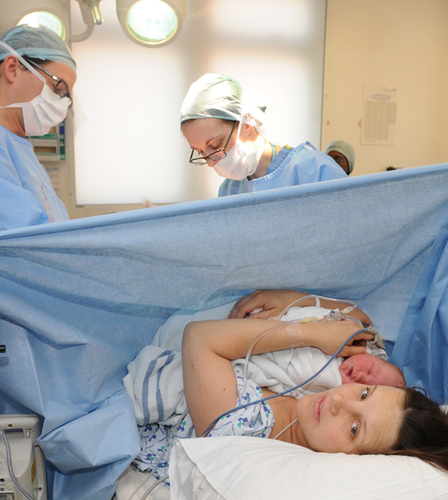Your partner's role How partners can help during a cesarean
You may think
that there is little a partner can do during a cesarean, but this is not
the case since your birth partner still has the important job of
supporting you during the surgery.
If the cesarean is an emergency procedure, partners can make sure that the reasons why this is necessary are clear.
If
you are awake for the procedure, your partner can remain in the room,
sitting by your head and offering you reassurance throughout the
surgery.
Once your baby is born, you and your partner can welcome her together.
Taking things slowly Getting back on your feet
Moving around in
the first couple of days after a cesarean is quite uncomfortable, but
the sooner you become mobile, the faster your recovery will be. However,
it's important to exercise caution and move with care.
When getting
out of bed, move on to your side and use your elbow to lever yourself
up, then slowly lower your legs onto the floor.
When standing, or if you cough or sneeze, place your hands over the site of your wound to avoid discomfort.
At
first, walk short distances only and avoid steps. If you feel dizzy,
sit down and rest, then try to walk again in a little while.
Recovering from a Cesarean
Although you should
remain mobile after a cesarean operation, it is also important that you
get plenty of rest. A cesarean is major surgery so you will need to
avoid lifting and carrying heavy loads for the first few weeks. Since
this may be difficult if you have other small children or are at home
alone, you should try and recruit as much help as possible after the
surgery. You should avoid doing any shopping, which usually involves
lifting, or driving for a few weeks. Check with your doctor for when
it's okay for you to drive again and make sure that you feel comfortable
wearing a seatbelt and doing maneuvers, including emergency stops. It
is generally thought to take up to six weeks to fully recover.
Taking it easy:
It's important to accept
that you have just undergone major surgery and that you need to allow
yourself as much rest as possible to aid your recovery.

NOTE
A cesarean doesn't mean you have failed—you have probably done what is in the best interests of you and your baby
NOTE
Don't worry about your cesarean scar. This will fade with time until it is a barely noticeable thin white line
Cesarean births How the procedure is carried out
A cesarean birth is when
your baby is born during an operation in which the surgeon lifts your
baby out through a short incision made through your abdomen (generally
below the pubic hair line) and through the wall of your uterus. This
surgery is performed under anesthetic, which could be spinal anesthesia,
epidural, or occasionally by general anesthetic. There are many
different reasons why a cesarean birth happens. Sometimes the decision
can be made during the pregnancy, which is called an elective cesarean,
and sometimes the decision is made during labor, which is known as an
emergency cesarean.
Today the cesarean birth
rate is 25 percent in the US and rising. Look at the statistics from
your doctor and local hospitals to see what their cesarean rates are to
help you decide where to have your baby. If you are considering an
elective cesarean, bear in mind that this is not without risks to you or
your baby, or even to your next pregnancy. The decision to have a
cesarean section should be made by weighing all the risks and then
making a decision that is right for you.
| Q: |
Can I avoid a cesarean?
|
| A: |
There are a few things you can do to help prevent a cesarean
section, for instance maintaining a healthy lifestyle during your
pregnancy, including adequate nutrition, not smoking, and not gaining
excessive weight. Other things, such as having someone with you
throughout your labor, a doula, a midwife, or a supportive partner;
having an external cephalic version (turning your baby while you are
about 37 weeks pregnant) if your baby is in a breech position; and also
having an experienced obstetrician involved in the decision not to have a
cesarean.
|
| Q: |
What type of anesthesia will I have?
|
| A: |
There are different types of anesthesia for cesareans, all of
which prevent you from feeling the operation. General anesthetics (which
make you go to sleep) are only used if your baby needs to be born
quickly or you have a rare blood disorder with low levels of platelets
(these help your blood to clot). More often, an injection is put into
your back, which is either a spinal block, when the drug is injected
into the spinal fluid, an epidural, or a combined spinal epidural; you
are awake to experience your baby being born and there are fewer
complications this way.
You will have an
intravenous drip in your arm and a urinary catheter (a tube draining
urine from your bladder) put in just before you have your cesarean, and
these will stay in place for about 24 hours. If you want to breast-feed,
you can do so as soon as the surgery is completed. It is important that
you are pain-free after your cesarean, so ask the nurses for more pain
relief if you need it, ideally before the pain builds up. To prevent
blood clots from forming in your legs, you may be asked to wear
compression stockings and after 24 hours, or preferably sooner, you will
be encouraged to get up and walk around.
|
| Q: |
How much can I do after a cesarean?
|
| A: |
Once you get home, take it easy and let the pain guide you as to
how much you do. You can start gently exercising as soon as you want
and most hospitals give you information as to which exercises you can do
safely. Using your vacuum cleaner, driving, and strenuous exercise are
definitely not recommended. You can drive again after six weeks,
depending on your doctor's advice.
|
| Q: |
Will I have to have a cesarean next time?
|
| A: |
The reason you had a cesarean this time will determine the
advice from your doctor as to whether you attempt a VBAC (vaginal birth
after cesarean) or have further cesareans for subsequent babies. If you
feel negative about the birth of your baby, you should try talking to
your doctor or hospital and get expert help, since it is common to feel
unhappy if you had an emergency cesarean when you were expecting a
vaginal birth.
|
The procedure
Preparation:
A fine, hollow needle
is inserted into your back and you will be given either an epidural or a
spinal block. The operation will start once the anesthetic is working,
in around 20 minutes.

The birth:
Once your baby has
been lifted out of the uterus, she is likely to give her first cry. The
umbilical cord will then be clamped and cut.

Your first hold:
While the
surgeon is completing the operation, delivering the placenta and
stitching together the uterus and the various layers of tissue, the baby
is handed to the mother or father to enjoy a first hold and cuddle.

Bikini line cut:
A horizontal incision is
made just above the top of your pubic area, along your bikini line. Once
the wound has healed, the scar is barely visible.